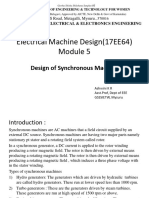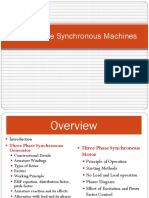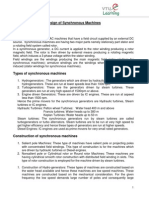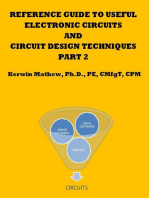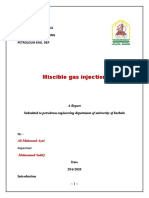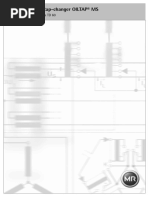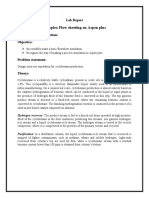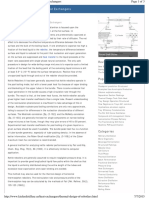Module 5-EMD
Uploaded by
AshwiniModule 5-EMD
Uploaded by
AshwiniElectrical Machine Design(21EE643)
Module 5
Design of Synchronous
Machine
Dept of EEE, GSSSIETW, Mysuru 1
Electrical Machine Design(21EE643)
Module 5
Design of Synchronous Machines
5.1 Introduction
Synchronous machines are AC machines that a field circuit supplied by an external DC
source. Synchronous machines are having two major parts namely stationary pt stator and a
rotating field system called rotor.
In a synchronous generator, a DC current is applied to the rotor winding producing a rotor
magnetic field. The rotor is then driven by external means producing a rotating magnetic
field. The rotor is then driven by external means producing a rotating magnetic field, which
induces a three-phase voltage with in the stator winding.
Types of synchronous machines
1) Hydro generators: The generators which are driven by hydraulic turbines are called
hydro generators. These run at lower speed less than 1000 rpm.
2) Turbo generators: These are the generators driven by steam turbines. These generators
are run at high-speed of 1500 rpm or above.
3) Engine driven generator: These are driven by IC engines. These are run at speed less
than 1500 rpm.
5.2 Construction: synchronous machines consisting of two parts namely
5.2.1 Stator: Stator is cylindrical in shape with circular laminations. Inner periphery of the
stator is slotted construction. Three phase windings are housed in these slots. The material is
used for stator construction is cast iron or sheet steel, CRGO lamination of 5mm thickness are
used.
5.2.2 Rotor: There are two types of rotor.
a) Salient pole type of rotor/projected pole type rotor :
In these types of rotor poles are projected from the rotor core. These poles are laminated
construction and firmly bolted to the rotor core. Since poles are projected these types of rotor
are mechanically week .These type of the rotors are used for the turbines which run at lower
speed i.e 250 rpm to 500 rpm.
Dept of EEE, GSSSIETW, Mysuru 2
Electrical Machine Design(21EE643)
b) Non salient pole type of rotor: Rotor surface appeared to be smooth, it is cylindrical
structure with slotted construction. The unslotted portion acts a pole. Rotor winding is
wound in slots. These types of rotors are mechanically strong with small diameter and
larger axial length. This type of rotor used for high-speed prime movers (1500 rpm to
3000 rpm).
5.3 Introduction to design: The aim of synchronous Machine is obtaining the following
information
1) Main dimensions of the stator frame i.eTo obtain the diameter D and gross length or
the stator.
2) Complete details of the stator winding i.e no of stator slots, stator slot pitch, no of
turns per phase, no of conductors per phase, shape of slots, size of conductors,
dimension of the slots etc..
3) Design details of the rotor i.e type of rotor, no of poles, no of rotor windings, length
of the air gap, diameter of the rotors, types of the rotor pole, size of rotor conductors
etc..
4) Performance details of the Synchronous machines i.e No load current, voltage
regulation, per unit reactance, efficiency etc.
Dept of EEE, GSSSIETW, Mysuru 3
Electrical Machine Design(21EE643)
In order to proceed with design and arrive at the above design information on should have the
following basic information.
a) Specification of the synchronous Machine i.e rated output of the machine KVA or
MVA rating synchronous machines, Voltage rating, Current rating, speed, frequency,
no of poles etc..
b) Information regarding choice of design parameters ie specific electric loading,
specific magnetic loading, slot pitch ranges, current density etc…
c) Knowledge on the availability of the materials
d) Limiting values such as temperature raise, over loading capacity of the machine etc.
e) Design equation required to obtain the design parameters i.emf equation, Output
equation etc..
(Derive the output equation of a 3 phase synchronous machine. And show that
𝑰𝒏𝒑𝒖𝒕 𝒊𝒏 𝑲𝑽𝑨 𝑿 𝜼 𝑿 𝐜𝐨𝐬 𝝓
HP=
𝟎.𝟕𝟒𝟔
)
5.4 Output Equation
Output equation of the three-phase synchronous generator is given by
Output of the machine Q = 3 𝑉𝑝ℎ 𝐼𝑝ℎ 10−3 KVA
Assuming Induced emf𝐸𝑝ℎ = 𝑉𝑝ℎ = 4.44 f φ𝑇𝑝ℎ 𝐾𝑤 X10−3
Output of the machine Q= 3 X4.44 fφ𝑇𝑝ℎ 𝐾𝑤 X10−3 X 𝐼𝑝ℎ
𝑃𝑁 𝑃𝑛𝑠 𝑁𝑠 𝑍𝑝ℎ
W.K.T f= 120𝑠 = (∵ 𝑛𝑠 = ) ,𝑇𝑝ℎ =
2 60 2
𝑃𝑛𝑠 𝑍𝑝ℎ
∴ Output Equation Q= 3 X4.44 X 2 X φ X X 𝐾𝑤 X10−3 X 𝐼𝑝ℎ ----------1
2
Re arranging the terms in Equation 1
Output Q = 1.11 X P φ X 3 𝐼𝑝ℎ 𝑍𝑝ℎ X 𝑛𝑠 X 𝐾𝑤 X10−3 ----------2
𝑃𝜙
Specific Magnetic loading Bav = 𝜋 𝐷 𝐿i.e. 𝑃𝜙 = 𝐵𝑎𝑣 𝜋𝐷𝐿 ----------3
3𝐼𝑝ℎ 𝑍𝑝ℎ
Specific Magnetic Loading q= or 3𝐼𝑝ℎ 𝑍𝑝ℎ = q 𝜋𝐷 ----------4
𝜋𝐷
Substituting Equation 3 and 4 in 2
Output in KVA Q = (1.11 𝜋 2 𝐵𝑎𝑣 𝑞𝐾𝑤 × 10−3 ) (𝐷2 L 𝑛𝑠 )
∴ Output in KVA Q = 𝑪𝒐 𝑫𝟐 L 𝒏𝒔
Where 𝐶𝑜 = Output Coefficient = 1.11 𝜋 2 𝐵𝑎𝑣 𝑞 𝐾𝑤 X10−3
w.k.t 𝑃𝑜𝑢𝑡 HP X 0.746 = 𝑃𝑜𝑢𝑡 kW -----------5
𝑃𝑜𝑢𝑡 kW = 𝑃𝑜𝑢𝑡 𝐾𝑉𝐴 𝑋 cos 𝜙 -----------6
𝑃𝑜𝑢𝑡 𝐾𝑉𝐴 = 𝑃𝑖𝑛 𝐾𝑉𝐴 × 𝜂 -----------7
From equation 6 & 7 substitute the values in 5
𝑃𝑜𝑢𝑡 in HP × 0.746 = 𝑃𝑖𝑛 𝐾𝑉𝐴 × 𝜂 × cos 𝜙
𝑷𝒊𝒏 𝑲𝑽𝑨 ×𝜼 ×𝐜𝐨𝐬 𝝓
∴ 𝑷𝒐𝒖𝒕 𝐢𝐧 𝐇𝐏 = Hence proved.
𝟎.𝟕𝟒𝟔
𝑉𝑝ℎ = Phase voltage, 𝐼𝑝ℎ = Phase current, φ = Flux per pole in Webers,
f= Frequency of the supply ,𝑁𝑠 = Synchronous speed in rpm,
Dept of EEE, GSSSIETW, Mysuru 4
Electrical Machine Design(21EE643)
D= Diameter of the stator, L = Length of the stator,𝑇𝑝ℎ = Turns per phase
𝑍𝑝ℎ = Conductors per phase, 𝐾𝑤 = Winding factor.
From the output equation it is clear that Output proportional to square of the diameter, Length
of the stator core, speed in rps.
5.5 Separation of D and L: From the output equation 𝐷2 L product is obtained. To
separate D and L suitable relations are assumed between D and L depending upon the type of
the generator.
5.5.1 For Salient pole machine either round or rectangular pole construction is employed. In
these types of machines diameter will be quite larger than the axial length.
a) Round pole: the ratio of pole arc to pole pitch may be assumed varying between o.6 to
0.7. Pole arc may be taken as approximately equal to axial length of the stator core
𝐴𝑥𝑖𝑎𝑙 𝐿𝑒𝑛𝑔𝑡ℎ 𝑜𝑓 𝑡ℎ𝑒 𝑐𝑜𝑟𝑠 𝐿
= 𝜏 = 0.6 to 07
𝑃𝑜𝑙𝑒 𝑝𝑖𝑡𝑐ℎ 𝑝
b) Rectangular pole: The ratio of axial length to pole pitch may be assumed varying
between 0.8 to 3.
𝐴𝑥𝑖𝑎𝑙 𝐿𝑒𝑛𝑔𝑡ℎ 𝑜𝑓 𝑡ℎ𝑒 𝑐𝑜𝑟𝑠 𝐿
= 𝜏 = 1 to 5
𝑃𝑜𝑙𝑒 𝑝𝑖𝑡𝑐ℎ 𝑝
Using above relations D and L can be determined. The values obtained must satisfy the
varies limiting values such as peripheral speed so that the rotor can with stand centrifugal
force produced. Limiting values of peripheral speed are
1) Bolted pole construction peripheral speed 𝑣𝑠 =𝜋𝐷𝑛𝑠 = 45 -50 m/s
2) Dove tail pole construction peripheral speed 𝑣𝑠 =𝜋𝐷𝑛𝑠 = 75- 80 m/s
3) Normal design peripheral speed 𝑣𝑠 =𝜋𝐷𝑛𝑠 = 30 m/s
5.5.2 For turbo alternators: Since the speed of these alternators of the order 3000 rpm.
Hence the diameter of the machine will be smaller than the axial length. Diameter of the rotor
is limited from the consideration of permissible peripheral speed limit. Peripheral speed for
these alternators must be below 175 m/s
5.6 Choice of specific Magnetic Loading: - The following factors to be considered while
choosing the specific Magnetic loading.
1) Iron Loss: Higher the value of flux density in the air gap leads to a high value of the
flux density in stator teeth and core, resulting higher iron loss, which results in
decrease in efficiency.
2) Voltage: Lower value of gap density should be used in high voltage machines to avoid
excessive value of flux density in teeth and core.
3) Transient short circuit current: A high value of gap density results in decrease in the
leakage reactance of the machine with consequent increase in initial value of armature
current under short circuit condition. In order to reduce the short circuit current low
value of gap density should be used to limit the initial electromagnetic forces under
short circuit conditions.
Dept of EEE, GSSSIETW, Mysuru 5
Electrical Machine Design(21EE643)
4) Stability: The maximum power which a cylindrical rotor machine can deliver under
𝐸𝑉
steady state condition is 𝑃𝑀𝑎𝑥 = 𝑋 where E is the excitation voltage, V is the
𝑠
terminal voltage.𝑋𝑠 is the synchronous reactance. The maximum power or the steady
state stability limit of a machine is inversely proportional to its synchronous
reactance. Therefore, the use of high gap density improves the steady state stability.
5) Parallel Operation: The synchronizing power is inversely proportional to the
synchronous reactance and therefore machine designed with high value of gap density
operate satisfactorily in
6) The following are the normal values of average gap density for the conventionally
cooled generator
1) Salient pole machine – 0.52 to 0.65 Wb/𝑚2
2) Turbo alternator -0.54 to 0.65 Wb/𝑚2 .
5.7 Choice of specific Electric loading: Electric loading influence the some of the working
factors in the machines which are mentioned below
1) Copper loss: High value of ampere conductor(ac) gives higher copper loss resulting in
lower efficiency and higher temperature rise. Higher values of ac are used in machine
which employ cooling techniques that effectively dissipate the generated heat.
2) Voltage: A higher value of ac can be used for low voltage machines since the space
required for insulation is small.
3) Synchronous Reactance: The value of ac affects the leakage reactance and armature
reaction in the machine. A machine designed with a high value of ac will have i) A Poor
inherent voltage regulation ii) low current under short circuit conditions iii) Low value for
steady state stability limit and small synchronizing powerand consequently leads to
instability.
4) Stray load loss: The stray load loss increases steeply with an increase in ac.
The following are the usual values for specific electric loadings, used in conventionally
cooled generators.
a) Salient pole machines – 20,000 to 40,000 A/m
b) Turbo Alternator – 50,000 to 75,000 A/m
(Define Short circuit Ratio in connection with 3phase synchronous generators. Explain
the factors affecting by SCR.)
5.8 Short Circuit Ratio: Short circuit ratio is defined as the ratio of field current
required to produce rated voltage on open circuit to field current required to circulate rated
current at short circuit.
According to the definition
𝑂𝐹𝑠 𝐶𝐹𝑆 𝐶𝐹𝑆 1
SCR = = = =
𝑂𝐹0 𝑏𝐹𝑆 𝑎𝐹𝑠 𝑎𝐹𝑠 ⁄𝐶𝐹𝑠
1
SCR = 𝑃𝑒𝑟 𝑢𝑛𝑖𝑡 𝑣𝑜𝑙𝑡𝑎𝑔𝑒 𝑜𝑛 𝑜𝑝𝑒𝑛 𝑐𝑖𝑟𝑐𝑢𝑖𝑡
𝑐𝑜𝑟𝑟𝑒𝑠𝑝𝑜𝑛𝑑𝑖𝑛𝑔 𝑝𝑒𝑟 𝑢𝑛𝑖𝑡 𝑐𝑢𝑟𝑟𝑒𝑛𝑡 𝑜𝑛 𝑠ℎ𝑜𝑟𝑡 𝑐𝑖𝑟𝑐𝑢𝑖𝑡
1
=
𝑋𝑠
𝑋𝑠 = Synchronous reactance
Short circuit ratio is defined as the reciprocal
Synchronous reactance. For Salient pole machine
SCR value should be in the range 0.9 to 1.3
For turbo alternator SCR value should be in the 0.7 to 1.1
Figure 5.4 OCC & SCC graph
Dept of EEE, GSSSIETW, Mysuru 6
Electrical Machine Design(21EE643)
5.8.1 Effect of SCR on machine performance
1) Voltage Regulation: Low value of SCR means that the synchronous reactance has a
large value synchronous machines with low value of SCR thus have greater changes
in voltage under fluctuations of loadi.e. the inherent voltage regulation of the machine
is poor.
2) Stability: A Machine with low SCR has lower stability limit as the maximum power
output of the machine is inversely proportional to 𝑋𝑠 .
3) Parallel operation : Machines with a low value of SCR are difficult to operate in
parallel because of high value of 𝑋𝑠 gives small synchronizing power. Also the
decreased synchronizing power is more likely to lead to disconnections of individual
units of apparatus and shut down from the operation of automatically reclosing type
circuit breaker.
4) Short circuit current: A Small value of SCR indicates a smaller value of current under
short circuit conditions owing to large value of synchronous reactance.
5) Self-excitation: Machine feeding long transmission lines with higher value of SCR
has a higher stability limit and a low value of inherent regulation. Higher value SCR
means a high values of short circuit current.
5.8 Design of stator
5.8.1 Design of Stator Winding: Stator winding is made up of wound coils of high
conductivity copper. These windings must be properly arranged such that the induced emf in
all the phases of the coils must have same magnitude and frequency and have phase
displacement of 120𝑜 to each other. Stator winding may be of star or delta connected. Single-
and double-layer windings may be connected depending on the requirement. Double layer
winding may be usually employed over single layer winding.
Following are the advantages and disadvantages of double layer windings
Advantages:
i) Better emf waveform can be obtained by using short pitched coil
ii) Saving in copper can be achieved by using short pitched coils, which reduces length
of the overhang.
iii) Lower cost of coils: Saving in copper leads to reduction in cost.
iv) Fractional slot windings: Only in double layer winding, leads to improvement in
waveforms.
Disadvantages:
i) Difficult to repair the lower layer of coils
ii) Difficulty in inserting the last coil of the winding
iii) More insulation is required for double layer winding
iv) Wider slot opening results in increased in air gap reluctance and noise.
(Discuss any five factors to be considered in selection of number of slots in synchronous
machines)
5.8.2 No of stator slots :
The no of slots are to be properly selected because the no of slots affect the cost and
performance of the machine. There are no rules for selecting the no of slots. But looking into
the advantage and disadvantages of higher no of slots. The following points are to be
considered for the selection of number of slot.
Dept of EEE, GSSSIETW, Mysuru 7
Electrical Machine Design(21EE643)
Advantages of higher no slots
• Reduced leakage reactance.
• Better cooling
• Decreased tooth ripples
Disadvantages of higher no of slots :
• Higher cost.
• Teeth becomes mechanically weak
• Higher flux density in teeth.
Slot loading must be less than 1500 AC/slot
Slot pitch must be with in the following limitations
i) Low voltage machines ≤ 3.5 𝑐𝑚
ii) Medium voltage machines upto 6kV ≤ 5.5 cm
iii) High voltage Machines upto 15kV ≤ 7.5 cm
5.8.3 Turns per phase 𝑻𝒑𝒉 : Turns per phase can be calculated from emf equation of the
alternator.( Winding Factor 𝐾𝑤 =0.99)
𝐵 𝜋𝐷𝐿
Flux per pole φ = 𝑎𝑣𝑃 Wb
𝐸𝐿
𝐸𝑝ℎ = volts
√3
𝐸𝑝ℎ =4.44 f φ𝑇𝑝ℎ 𝐾𝑤
𝐸
𝑇𝑝ℎ =4.44 𝑓𝑝ℎ𝜙𝐾 turns
𝑤
5.8.4 Area of cross section of the conductor 𝒂𝒔 : Area of cross section of the conductor is
estimated by stator current and suitable value of current density.
𝐼
Cross sectiononal area of stator conductor 𝑎𝑠 =𝛿𝑠
𝑠
Advantages of higher value of current density.
• Reduction in cross section
• Reduction in weight
• Reduction in cost.
Disadvantages of higher value of current density
• Increase in resistance
• Increase in copper loss
• Increase in temperature rise
• Reduction in efficiency.
Hence higher value is assumed for low voltage machines and small machines. Usual value of
current density for stator winding is 3 to 5 A/𝑚𝑚2 .
5.8.5 Dimension of stator slots: Width of the slot = slot pitch – tooth width. The flux density
in the stator tooth should not exceed 1.8 to 2.0 tesla. In a salient pole alternator internal
diameter is quite large and the flux density along the depth of the tooth does not vary
Dept of EEE, GSSSIETW, Mysuru 8
Electrical Machine Design(21EE643)
appreciably. Hence width of the tooth may be estimate corresponding to the permissible flux
density at the middle section of the tooth. The flux density should not exceed 1.8 Tesla.
Figure 5.5 OCC & SCC graph
(a)For salient pole alternator:
Flux density at the middle section = Flux/pole (width of the tooth at the middle section X iron
length X number of teeth per pole arc)
Number of teeth per pole arc =pole arc/slot pitch.
(b) For turbo alternator:
Flux density at the top section = Flux/pole ( width at the top section X iron length X number
of teeth per pole pitch)
As the 2/3rd pole pitch is slotted the number of teeth per pole pitch = 2/3 X pole pitch (slot
pitch at top section)
Slot width = slot pitch at the top section – tooth width at the top section.
Once the width of the slot is estimated the insulation required width wise and the space
available for conductor width wise can be estimated.
(c) Slot insulation width wise
• Conductor insulation
• Mica slot liner
• Binding tape over the coil
• Tolerance or clearance
• Space available for the conductor width wise = width of the slot-insulation width wise
(d) Depth of the slot :
• Space occupied by the conductors = depth of each conductor X no.of conductor per
slot.
• Conductor insulation.
• Mica liner.
• Mica or bituminous layers to separate the insulated conductors
• Coil separator between the layers
• Wedge.
• Lip
• Tolerance or clearance.
5.8.6 Mean length of the turn(𝒍𝒎𝒕 ):
The length of the mean turns depends on the following factors
i) Gross length of the stator core : Each turn consists of two times the gross length of
stator core.
Dept of EEE, GSSSIETW, Mysuru 9
Electrical Machine Design(21EE643)
ii) Pole pitch : the over hang portion of the coils depend upon the coil span which in turn
depends upon the pole pitch.
iii) Voltage of the machine : The insulated conductor coming out of the stator slot should
have straight length beyond the stator core which depends upon the voltage rating of
the machine.
iv) Slot dimensions: Length per turn depends on the average size of the slot.
Hence mean length of the turn in double layer winding of synchronous machine is estimated
as follows
𝐿𝑚𝑡 =2L +2.5𝜏𝑝 + 5kV + 15cm.
5.8.7 Resistance of the stator winding: Knowing the length of the mean turn, sectional area
of stator conductor and number of turns per phase, resistance of the stator winding can be
calculated as given below.
𝜌𝑙𝑚𝑡 𝑇𝑝ℎ
Resistance of stator winding 𝑅𝑠 = Ω
𝑎𝑠
Where, 𝜌= resistivity, 𝑎𝑠 = cross sectional area of the conductor in 𝑚𝑚2
(What are steps involved in design of field windings of a synchronous machine?)
5.9 Design of field winding system of Salient pole alternator
5.9.1 Shape of the pole face : For salient pole alternator, pole and pole shoe should be
suitably shaped to obtain a sinusoidal wave form of the generated emf. The length of the air
gap at the pole tips should be approximately 1.5 to 2.25 times that at the center of the pole for
achieving practically sinusoidal distribution. The height of the pole shoe is kept higher for
alternators provided with damper windings in the pole faces. The ratio of pole arc to pole
pitch for salient pole alternators should be properly selected. The best ratio to reduce the flux
leakage and overhang of pole shoe is 0.7.
5.9.2 Dimensions of the Pole :
(a)Axial length : Axial length of the pole may be taken 1 to 1.5cm less than the stator core
length, so that rotor can oscillate freely.
(b)Width of the pole : For salient pole alternator, round or rectangular poles are generally
used. Area of cross section of the pole body can be found out, based upon the flux in the pole
body and the flux density in the pole.
𝜙𝑝
Cross sectional area of pole body , 𝐴𝑝 = 𝐵
𝑝
Leakage factor for the pole may be approximately taken as 1.1 to 1.15
Thus 𝜙𝑝 =(1.1 to 1.15)ϕ
Flux density, 𝐵𝑝 in the pole body may be assumed varying from 1.4 to 1.6 Tesla.
i)For Rectangular poles :Cross-sectional area of pole body, Ap =0.95Lp bp Where, 0.95 is
Ap
stacking factor. Thus, Width of the pole body, bp =0.95 L
p
π
ii)For Round poles : Cross-sectional area of pole body Ap =4 bp 2 Thus, diameter of round
pole, bp can be found out.
Dept of EEE, GSSSIETW, Mysuru 10
Electrical Machine Design(21EE643)
c) Height of the pole: The height of the pole should be selected in such a way that it can
conveniently accommodate the total full load field ampere turns to provided on the pole in
the form of exciting coil.
2.7 𝐼𝑝ℎ 𝑇𝑝ℎ 𝐾𝑤
Armature ampere turns per pole 𝐴𝑇𝑎 = 𝑃
Thus, approximate value of full load field ampere turns per pole,
𝐴𝑇𝑓𝑙 =(1.7 to 2) 𝐴𝑇𝑎
Height of the pole can be calculated by based on the height of the field coil and insulation .
Height of the field coil can be calculated by following steps.
2 2 𝜌𝑙𝑚𝑡𝑓 𝑇𝑓
Copper loss per coil =(𝐼𝑓 ) 𝑅𝑓 = (𝐼𝑓 ) [ ]
𝑎𝑓
More over, total copper area in the field coil = 𝑎𝑓 𝑇𝑓 = (𝑑𝑓 𝑋ℎ𝑓 ) 𝑆𝑓
𝑑𝑓 ℎ𝑓 𝑆𝑓
∴ Area of the field coil 𝑎𝑓 = 𝑇𝑓
2 𝜌𝑙 𝑇 2 𝜌𝑙𝑚𝑡𝑓
∴ Copper loss in the field coil = (𝐼𝑓 ) [ 𝑑𝑓𝑚𝑡𝑓 𝑓
ℎ𝑓 𝑆𝑓 ]= (𝐼𝑓 𝑇𝑓 ) [𝑑 ] Watts
𝑓 ℎ𝑓 𝑆𝑓
𝑇𝑓
Losses dissipated from the field coil = 𝑝𝑓 X cooling surface of field coil.
Inner and outer surfaces of the field coils are effective in dissipating the heat.
Thus the cooling surface of the field coil = 2 𝑙𝑚𝑡𝑓 X ℎ𝑓
Hence, losses dissipated from the field coil = 2 𝑙𝑚𝑡𝑓 X ℎ𝑓 X 𝑝𝑓
The copper losses in the field coil= losses dissipated from the field coil
2 𝜌𝑙𝑚𝑡𝑓
(𝐼𝑓 𝑇𝑓 ) [𝑑 ]= 2 𝑙𝑚𝑡𝑓 X ℎ𝑓 X 𝑝𝑓
𝑓 ℎ𝑓 𝑆𝑓
𝜌 𝐼𝑓 𝑇 𝑓
Thus, height of field coil ℎ𝑓 = (𝐼𝑓 𝑇𝑓 ) √2𝑑 = 104
𝑓 ℎ𝑓 𝑆𝑓 √𝑑𝑓 ℎ𝑓 𝑆𝑓
∴ Height of the pole 𝐻𝑝 = Height of the field winding + height of the pole shoe +insulation
height between windings/coil frame
∴ Height of the pole 𝐻𝑝 = ℎ𝑓 + height of pole shoe and insulation height.
Where,
𝐼𝑓 = Current in the field winding, 𝑎𝑓 =area of the field winding,
𝑇𝑓 = Total no of turns in each field coil, 𝑅𝑓 =Resistance of the field coil
𝑙𝑚𝑡𝑓 =mean length of turn of field coil, 𝜌= spcific resistance of the field coil
𝑑𝑓 =depth of field coil , ℎ𝑓 = height of the field coil. 𝑆𝑓 =Copper space factor
𝑃𝑓 = permissible loss per 𝑚2 of cooling surface w/𝑚2
Depth of the field winding 𝑑𝑓 - Its value may be assumed varying from 0.03 to 0l05 m.
5.10 Design of Field winding for salient pole Alternator.
Aim of in the design of field winding is to achieve the following information regarding this
winding, based on the design data of the field system already calculated and voltage rating of
the machine.
1) Cross sectional area of the conductor for the winding.
2) Current in field winding.
3) Number of turns.
4) Proper arrangements of the windings
5) Resistance of the winding.
6) Copper loss in the field winding.’
Dept of EEE, GSSSIETW, Mysuru 11
Electrical Machine Design(21EE643)
(What are the steps involved in the design of field winding of a salient pole alternator?)
Procedure for calculating the above information has been discussed below
1. Exciter voltage for altenator may be taken varying from 110 to 400Volts. For small and
medium rating exciter voltage 110 to 220Volts. Field winding is generally designed for 80
to 85% of the exciter voltage.
(0.8 𝑡𝑜 0𝑙85)𝐸𝑥𝑐𝑖𝑡𝑒𝑟 𝑉𝑜𝑙𝑡𝑎𝑔𝑒
Thus, Voltage per field coil, 𝑉𝑐 = 𝑁𝑜 𝑜𝑓 𝑓𝑖𝑒𝑙𝑑 𝑐𝑜𝑖𝑙
Number of field coils will be equal to the number of poles.
2. A suitable value is assumed for the depth of the filed coil, 𝑑𝑓 depending upon the pole
pitch.
3. Mean length of the turn of field coil is estimated from the dimensions of the pole and the
depth of the field windings.
Mean length of turn 𝑙𝑚𝑡𝑓 = 2(𝑙𝑝 +𝑏𝑃 )+𝜋(𝑑𝑓 +2𝑡𝑖 )
𝑡𝑖 = thickness of insulation wrapping on the pole.
4. Sectional area of the conductor is calculated from the full load ampere turns, mean length
of turn and voltage across each coil.
𝜌𝑙 𝑇𝑓 𝑉𝑜𝑙𝑡𝑎𝑔𝑒 𝑎𝑐𝑟𝑜𝑠𝑠 𝑒𝑎𝑐ℎ 𝑐𝑜𝑖𝑙 𝑉𝑐
Resistance of field coil, 𝑅𝑓 = 𝑚𝑡𝑓 = =𝐼
𝑎 𝑓 𝐹𝑖𝑒𝑙𝑑 𝑐𝑢𝑟𝑟𝑒𝑛𝑡 𝑓
𝜌𝑙𝑚𝑡𝑓 (𝐼𝑓 𝑇𝑓 ) 2
Sectional area of field conductor, 𝑎𝑓 = 𝑚𝑚
𝑉𝑐
5. Field current is estimated by assuming a suitable value of current density in the field
winding, 𝛿𝑓 in the field winding may be take varying from 3.5 to 4.0 A/𝑚𝑚2
6. The field current 𝐼𝑓 =𝛿𝑓 X 𝑎𝑓
7. 6) Number of turns in the field winding can now be calculated from load ampere turns
and the field current.
𝐹𝑢𝑙𝑙 𝑙𝑜𝑎𝑑 𝑓𝑖𝑒𝑙𝑑 𝑎𝑚𝑝𝑒𝑟𝑒 𝑡𝑢𝑟𝑛𝑠
8. Number of turns 𝑇𝑓 = 𝐹𝑖𝑒𝑙𝑑 𝑐𝑢𝑟𝑟𝑒𝑛𝑡.
9. 7) Approximate value of the depth of the field winding and the height of field coil have
already been calculated . Thus field turns can now be arranged in the space available. In
case, field turns are not adjusted properly, the windings depth may be increased
accordingly.
10. 8) Resistance of the field winding can now be detemined
𝜌𝑙𝑚𝑡𝑓 𝑇𝑓
11. 𝑅𝑓 = 𝑎𝑓
12. 9) Calculate the copper losses of the field winding ,copper losses =𝐼𝑓 2 𝑅𝑓 watts
----------------------------------------------------------------------------------------------------------------
5.10 Design of Turbo alternator / Non salient pole type of rotor :
a) Design of stator : The design of stator of turbo-alternator and water generator is quite
similar, however the difference between the two types of alternators regarding the stator
design have already been discussed earlier.
b) Design of the rotor: In case of turbo alternators, the rotor winding is not concentrated ,
but distributed in rotor slots. Normally 70% of the rotor slots are wound and the rest 30%
are left unwound, so as to form the pole arc.
c) Selection of number of rotor slots: The total number of slots on the rotor may be
assumed varying from 50 t0 70 % of the stator slots. However, the number of rotor slots
Dept of EEE, GSSSIETW, Mysuru 12
Electrical Machine Design(21EE643)
thus found out must satisfy the following condition in order to avoid the undesirable
harmonics in the flux density wave.
There should be no common factor between the number of rotor slot pitches and the
number of stator slot pitches. Number of wound rotor slots should be divisible by 4 for 2
pole alternator. Moreover, the width of the rotor slot should be limited, keeping in view
the stresses developed at the root of the rotor teeth.
(What are the steps involved in the design of filed winding of non salient pole
alternator?)
d) Procedure to Design of the rotor winding for non-salient pole : The following steps
may be adopted for designing the rotor winding of turbo-alternators.
1) Full load ampere turns per pole can be assumed twice the armature ampere turns per pole
𝐼𝑝ℎ 𝑇𝑝ℎ 𝑘𝑤
i.e. 2X(1.35 )
𝑝
2) Assume standard exciter voltage,such as 220volts, with 15 to 20% reserve
(0.8 𝑡𝑜 0𝑙85)𝐸𝑥𝑐𝑖𝑡𝑒𝑟 𝑉𝑜𝑙𝑡𝑎𝑔𝑒
Thus voltage per coil 𝑉𝑐 = 𝑁𝑜 𝑜𝑓 𝑓𝑖𝑒𝑙𝑑 𝑐𝑜𝑖𝑙
3)Find out the mean length of the turn using approximate formula,
𝑙𝑚𝑡 =2L+1.8𝜏𝑝 +0.25m
4)Calculate the sectional area of the field conductor using the following equation
𝜌𝑙𝑚𝑡 (𝐼𝑓 𝑇𝑓 )
𝑎𝑓 = 𝑉𝑐
5)Assume suitable value of current density in the filed winding. For conventionally cooled
machines lower value of current densities in the range 2.5 to 3 A/𝑚𝑚2 can be assumed. In
the large rating alternators, which are direct cooled, much higher current density of the order
8 to 12 A/𝑚𝑚2 can be taken.
2 𝑋 𝐼𝑓 𝑇 𝑓
6) Find out area of all the rotor conductors per pole i.e 𝛿𝑓
2𝐼𝑓 𝑇𝑓
7) Calculate the number of rotor conductors per pole i.e. 𝛿𝑓 𝑎𝑓
8) Find out the number of wound rotor slots per pole, then number of conductor per slot. The
number of conductors per slot should be rounded off properly.
9) Calculate modified value of the conductors per pole and field turns per pole.
𝜌𝑙𝑚𝑡 𝑇𝑓
10) Find out the resistance of field coil per pole 𝑅𝑓 = 𝑎𝑓
𝑉𝑐
11) Calculate the current in the field winding 𝐼𝑓 = 𝑅
𝑓
12) Find out modified value of field ampere turns per pole. Based on the above data fix the
dimensions of the rotor slot. Normally slot depth to slot width ratio may be of the order of 4
to 5. The insulation must be provided to withstand i) Large mechanical stress ii) The forces
which are due to expansion of the slot contents.
(What are the different parts where the insulation is provided for the field coils)
Generally , following insulation may be provided on the field coil.
i) 0.5 mm hard mica cell is provided all around the field coil.
ii) Over the above , 1.5mm flexible mica cell is provided on the filed coil.
iii) Lastly a steel cell of 0.6mm enclose the whole field coil. In addition to the above ,
various turns in the rotor slot height are separated from each other by 0.3 mm pressed
mica separators.
Dept of EEE, GSSSIETW, Mysuru 13
You might also like
- Design of Armature Stator of Ac GeneratorNo ratings yetDesign of Armature Stator of Ac Generator18 pages
- Study of a reluctance magnetic gearbox for energy storage system applicationFrom EverandStudy of a reluctance magnetic gearbox for energy storage system application1/5 (1)
- Constructional Details:: 1. Explain The Construction Details of Synchronous MotorNo ratings yetConstructional Details:: 1. Explain The Construction Details of Synchronous Motor28 pages
- Analysis of Brushless Three-Phase Synchronous Generator Without ExciterNo ratings yetAnalysis of Brushless Three-Phase Synchronous Generator Without Exciter10 pages
- Module 3. Design of 3 Phase Induction Motor83% (6)Module 3. Design of 3 Phase Induction Motor43 pages
- Three Phase Synchronous Machines - 2015No ratings yetThree Phase Synchronous Machines - 201593 pages
- Design and Dynamic Analysis of An Axially-Laminated Self-Starting Synchronous Reluctance MotorNo ratings yetDesign and Dynamic Analysis of An Axially-Laminated Self-Starting Synchronous Reluctance Motor6 pages
- Lecture 1 - Construction of Synchronous Generator100% (1)Lecture 1 - Construction of Synchronous Generator11 pages
- 2011 Design and Construction of Axial Flux Permanent Magnet Generator For Wind Turbine Generated DC Voltage at Rated Power 1500 W (Office)100% (1)2011 Design and Construction of Axial Flux Permanent Magnet Generator For Wind Turbine Generated DC Voltage at Rated Power 1500 W (Office)4 pages
- FIGURE 3.1 Switched Reluctance Motor Configurations. (A) One Tooth Per Pole. (B) Two Teeth Per Pole (12/10 Poles)No ratings yetFIGURE 3.1 Switched Reluctance Motor Configurations. (A) One Tooth Per Pole. (B) Two Teeth Per Pole (12/10 Poles)32 pages
- ED Lab Manual Original - Exp 1 To Exp 5No ratings yetED Lab Manual Original - Exp 1 To Exp 519 pages
- Bahir Dar Institute OF Technology: Synchronous MachinesNo ratings yetBahir Dar Institute OF Technology: Synchronous Machines18 pages
- Unit 4 Three Phase Induction Motor Design - Part 1No ratings yetUnit 4 Three Phase Induction Motor Design - Part 131 pages
- Advanced Electric Drives: Analysis, Control, and Modeling Using MATLAB / SimulinkFrom EverandAdvanced Electric Drives: Analysis, Control, and Modeling Using MATLAB / SimulinkNo ratings yet
- Power System Transient Analysis: Theory and Practice using Simulation Programs (ATP-EMTP)From EverandPower System Transient Analysis: Theory and Practice using Simulation Programs (ATP-EMTP)No ratings yet
- Electrical Machines: Lecture Notes for Electrical Machines CourseFrom EverandElectrical Machines: Lecture Notes for Electrical Machines CourseNo ratings yet
- Influence of System Parameters Using Fuse Protection of Regenerative DC DrivesFrom EverandInfluence of System Parameters Using Fuse Protection of Regenerative DC DrivesNo ratings yet
- Reference Guide To Useful Electronic Circuits And Circuit Design Techniques - Part 2From EverandReference Guide To Useful Electronic Circuits And Circuit Design Techniques - Part 2No ratings yet
- Main Dimension problems & Solution Module 2 (1)No ratings yetMain Dimension problems & Solution Module 2 (1)11 pages
- IB Program 2023 & 2024w21 Base Vehicle: IB2309 IB2321 IB2337 IB2347 Version: w2302.2 IB2409 IB2421No ratings yetIB Program 2023 & 2024w21 Base Vehicle: IB2309 IB2321 IB2337 IB2347 Version: w2302.2 IB2409 IB24219 pages
- Liquid Drop Model and Bohr-Wheeler Theory of Nuclear Fission100% (1)Liquid Drop Model and Bohr-Wheeler Theory of Nuclear Fission6 pages
- Anna Star Labour Accommodation Profile.No ratings yetAnna Star Labour Accommodation Profile.124 pages
- Eaton 93e Ups 40kva 60kva Generation 3 ManualNo ratings yetEaton 93e Ups 40kva 60kva Generation 3 Manual120 pages
- MR - SLIM With Heat Pump Lineup Catalogue: InverterNo ratings yetMR - SLIM With Heat Pump Lineup Catalogue: Inverter20 pages
- Ficha Tecnica Driver Done Brasil PremiumNo ratings yetFicha Tecnica Driver Done Brasil Premium6 pages
- Chapter 8 - Mechanical Properties of Metals - Week 6&7100% (1)Chapter 8 - Mechanical Properties of Metals - Week 6&740 pages
- 17.7-Energy Work Power-Cie Igcse Physics Ext-Theory-Qp CombiNo ratings yet17.7-Energy Work Power-Cie Igcse Physics Ext-Theory-Qp Combi10 pages
- Study of a reluctance magnetic gearbox for energy storage system applicationFrom EverandStudy of a reluctance magnetic gearbox for energy storage system application
- Constructional Details:: 1. Explain The Construction Details of Synchronous MotorConstructional Details:: 1. Explain The Construction Details of Synchronous Motor
- Analysis of Brushless Three-Phase Synchronous Generator Without ExciterAnalysis of Brushless Three-Phase Synchronous Generator Without Exciter
- Design and Dynamic Analysis of An Axially-Laminated Self-Starting Synchronous Reluctance MotorDesign and Dynamic Analysis of An Axially-Laminated Self-Starting Synchronous Reluctance Motor
- 2011 Design and Construction of Axial Flux Permanent Magnet Generator For Wind Turbine Generated DC Voltage at Rated Power 1500 W (Office)2011 Design and Construction of Axial Flux Permanent Magnet Generator For Wind Turbine Generated DC Voltage at Rated Power 1500 W (Office)
- FIGURE 3.1 Switched Reluctance Motor Configurations. (A) One Tooth Per Pole. (B) Two Teeth Per Pole (12/10 Poles)FIGURE 3.1 Switched Reluctance Motor Configurations. (A) One Tooth Per Pole. (B) Two Teeth Per Pole (12/10 Poles)
- Bahir Dar Institute OF Technology: Synchronous MachinesBahir Dar Institute OF Technology: Synchronous Machines
- Unit 4 Three Phase Induction Motor Design - Part 1Unit 4 Three Phase Induction Motor Design - Part 1
- Advanced Electric Drives: Analysis, Control, and Modeling Using MATLAB / SimulinkFrom EverandAdvanced Electric Drives: Analysis, Control, and Modeling Using MATLAB / Simulink
- Analog Dialogue, Volume 48, Number 1: Analog Dialogue, #13From EverandAnalog Dialogue, Volume 48, Number 1: Analog Dialogue, #13
- Power System Transient Analysis: Theory and Practice using Simulation Programs (ATP-EMTP)From EverandPower System Transient Analysis: Theory and Practice using Simulation Programs (ATP-EMTP)
- Electrical Machines: Lecture Notes for Electrical Machines CourseFrom EverandElectrical Machines: Lecture Notes for Electrical Machines Course
- Influence of System Parameters Using Fuse Protection of Regenerative DC DrivesFrom EverandInfluence of System Parameters Using Fuse Protection of Regenerative DC Drives
- Reference Guide To Useful Electronic Circuits And Circuit Design Techniques - Part 2From EverandReference Guide To Useful Electronic Circuits And Circuit Design Techniques - Part 2
- IB Program 2023 & 2024w21 Base Vehicle: IB2309 IB2321 IB2337 IB2347 Version: w2302.2 IB2409 IB2421IB Program 2023 & 2024w21 Base Vehicle: IB2309 IB2321 IB2337 IB2347 Version: w2302.2 IB2409 IB2421
- Liquid Drop Model and Bohr-Wheeler Theory of Nuclear FissionLiquid Drop Model and Bohr-Wheeler Theory of Nuclear Fission
- MR - SLIM With Heat Pump Lineup Catalogue: InverterMR - SLIM With Heat Pump Lineup Catalogue: Inverter
- Chapter 8 - Mechanical Properties of Metals - Week 6&7Chapter 8 - Mechanical Properties of Metals - Week 6&7
- 17.7-Energy Work Power-Cie Igcse Physics Ext-Theory-Qp Combi17.7-Energy Work Power-Cie Igcse Physics Ext-Theory-Qp Combi



